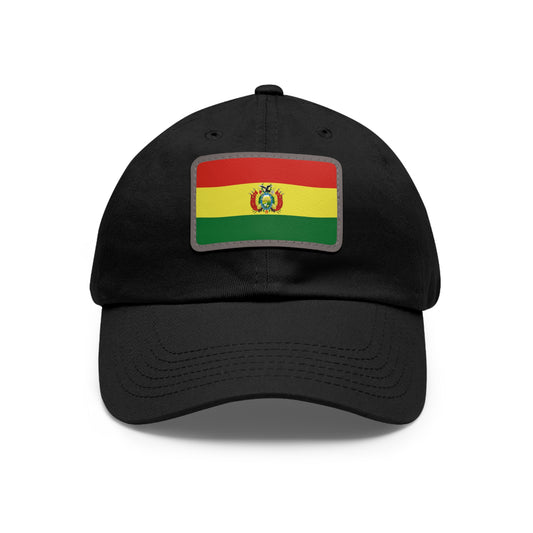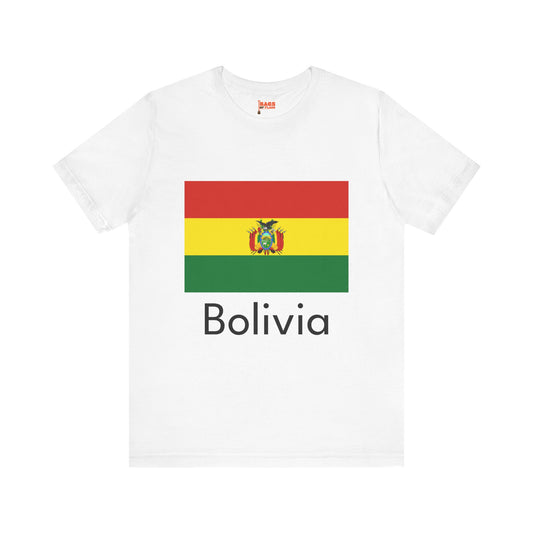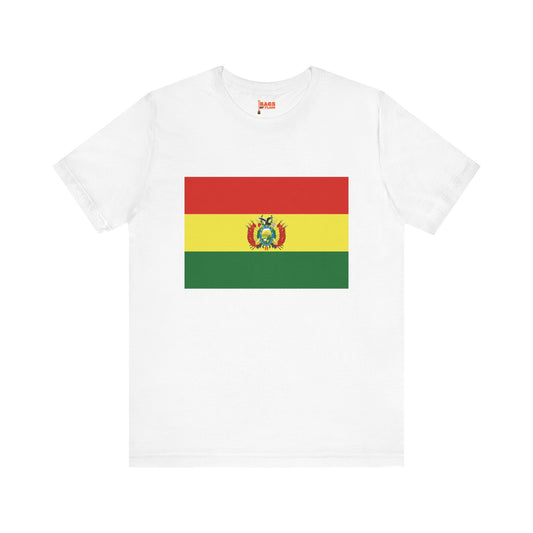-
Bolivia Leather Patch Hat
Regular price $18.85 USDRegular priceUnit price / per -
Bolivia Backpack
Regular price $59.79 USDRegular priceUnit price / per -
Bolivia Pillow
Regular price $22.65 USDRegular priceUnit price / per -
Bolivia Sweatshirt
Regular price $34.15 USDRegular priceUnit price / per -
Bolivia Flag Sweatshirt
Regular price $34.15 USDRegular priceUnit price / per -
Bolivia Mug
Regular price $11.65 USDRegular priceUnit price / per -
Bolivia Trucker Cap
Regular price $14.90 USDRegular priceUnit price / per -
Bolivia Hoodies
Regular price $34.40 USDRegular priceUnit price / per -
Bolivia T-shirts
Regular price $22.79 USDRegular priceUnit price / per -
Bolivia Flag on Hoodie
Regular price $34.40 USDRegular priceUnit price / per -
Bolivia Flag on T-shirt
Regular price $22.79 USDRegular priceUnit price / per
Collection: Bolivia
The Bolivian flag, also known as the flag of Bolivia, is a vibrant symbol of the country's history, culture, and identity. With its striking design and bold colors, the flag represents Bolivia's rich heritage and diverse population.
Overview of the Bolivian Flag

The Bolivian flag is comprised of a trio of horizontal bands painted in red, yellow, and green, from top to bottom, respectively. Dominating the flag's center is the Bolivian coat of arms, an emblem rich in national symbolism. The red band captures the valor and sacrifices made during Bolivia's pursuit of independence. Yellow, occupying the flag's central position, reflects the nation’s abundant wealth, particularly in minerals and other natural resources.
Finally, the green stripe at the bottom symbolizes the fertility of Bolivia’s land, embodying the nation's hope and verdant landscapes. Together, these elements not only define the flag's physical appearance but also weave a narrative of Bolivia's past, natural bounty, and aspirations for the future. Including the coat of arms adds depth, showcasing symbols of Bolivia's sovereignty and resilience, further unifying the nation under a banner of shared history and values.
Historical Context of the Bolivian Flag

Adopted on October 31, 1851, the flag of Bolivia has been a symbol of national identity and sovereignty for nearly two centuries. Throughout its history, this emblem has seen various iterations, reflecting the nation's evolving political and social landscape. The initial adoption came at a pivotal moment, during a period of consolidation and redefinition following Bolivia's hard-won independence from Spanish rule in 1825. Over the years, modifications to the flag's design often indicated broader changes within the country, with each alteration aimed at encapsulating the spirit and aspirations of the Bolivian people at that time.
Significantly, the choice of colors and the addition of the coat of arms were not merely aesthetic decisions but were imbued with deep nationalistic sentiment and purpose. These elements were selected to forge a visual narrative connecting Bolivians to their past struggles, rich natural heritage, and collective hopes for the future. Therefore, the alterations to the flag have been more than cosmetic; they have served as milestones marking Bolivia's journey as a nation, embodying the shifts in societal values and the political climate. Each version of the flag has carried forward the legacy of its predecessors while introducing symbols and colors that resonate with Bolivia's evolving identity and unity.
The symbolism of the Bolivian Flag
Each component of the Bolivian flag's design carries deep symbolic meaning, intricately linked to the nation's identity and values. The top red stripe is a tribute to the bravery and bloodshed of those who fought for Bolivia's independence, embodying the sacrifices made for freedom. Centered, the yellow band reflects the country’s vast mineral riches and other natural resources, a nod to the wealth beneath its soil and the prosperity it brings to the nation.
The green stripe at the base represents the abundant fertility of Bolivia's land, a symbol of growth, renewal, and the promise of the future. Embedded at the heart of the flag, the coat of arms acts as a beacon of national pride, featuring a condor soaring above a mountain peak, encapsulating Bolivia's aspirations, resilience, and sovereignty. Together with laurel and palm branches, it conveys a message of peace and victory. Through these elements, the flag weaves a narrative that honors Bolivia's historical struggles, celebrates its natural abundance, and embodies its hopes for a prosperous future, uniting Bolivians under a common banner of shared heritage and aspirations.
Current Relevance of the Bolivian Flag
In contemporary Bolivia, the flag remains a central emblem of national identity, prominently featured at a wide array of public events, from state celebrations to sports competitions. Its presence is a testament to the enduring pride and unity among the Bolivian people, transcending regional and cultural differences. The flag is also integral to military honors and political functions, symbolizing the country's sovereignty and the government's authority. Yet, its role extends beyond formal occasions; it is a familiar sight in everyday life, adorning public buildings, schools, and homes nationwide.
Despite its ubiquity, the flag has not been immune to controversy. In recent years, heated debates have been over its representation and symbolism, particularly concerning the inclusion and recognition of indigenous cultures within the national narrative. These discussions reflect broader societal conversations about identity, heritage, and inclusivity in Bolivia. Moreover, the flag's use in protests and political rallies underscores its power as a symbol of resistance and demand for change, highlighting its significance not only as a marker of national identity but also as an instrument for political expression and activism. In these contexts, the Bolian flag serves as a rallying point for diverse groups, affirming its role as a living symbol of the nation's ongoing struggles and aspirations.
Additional Facts About the Bolivian Flag
Respecting and honoring the Bolivian flag involves a set of specific protocols that underscore its importance to the nation's heritage. One of the paramount rules is that the flag should never be allowed to touch the ground, symbolizing respect for the sacrifices and ideals it represents. When raising or lowering the flag, ceremonies are conducted with solemnity and reverence, reflecting the flag's significance as a national symbol. Beyond official protocols, the flag plays a central role in Bolivia’s cultural practices. It is prominently featured during significant events like Independence Day celebrations, where it adorns streets and homes, fostering a sense of unity and national pride.
An intriguing aspect of the flag that many may not be aware of is its connection to other South American countries. The design and color scheme of the Bolian flag was inspired by the flags of Argentina and Peru, highlighting the shared histories and solidarity among these nations. This detail enriches the flag's story and serves as a reminder of the interconnectedness of countries within the region. These unique practices and historical connections enrich the tapestry of Bolivia's national flag, adding layers of meaning to its already rich symbolism.






















